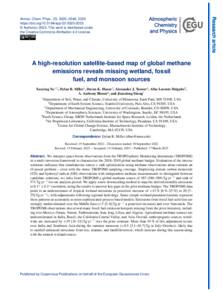وثيقة
A High-resolution satellite-based map of global methane emissions reveals missing wetland, fossil fuel, and monsoon sources.
المعرف
doi:10.1111/j.1469-1795.2012.00547.x
المساهمون
Millet, Dylan B., مؤلف
Henze, Daven K., مؤلف
Turner, Alexander J., مؤلف
Delgado, Alba Lorente., مؤلف
Bloom, A. Anthony., مؤلف
Sheng, Jianxiong., مؤلف
الناشر
Copernicus Publications.
ميلادي
2023-03
اللغة
الأنجليزية
الملخص الإنجليزي
We interpret space-borne observations from the TROPOspheric Monitoring Instrument (TROPOMI)
in a multi-inversion framework to characterize the 2018–2019 global methane budget. Evaluation of the inverse
solutions indicates that simultaneous source + sink optimization using methane observations alone remains an
ill-posed problem – even with the dense TROPOMI sampling coverage. Employing remote carbon monoxide
(CO) and hydroxyl radical (OH) observations with independent methane measurements to distinguish between
candidate solutions, we infer from TROPOMI a global methane source of 587 (586–589) Tg yr−1
and sink of
571 Tg yr−1
for our analysis period. We apply a new downscaling method to map the derived monthly emissions
to 0.1◦ × 0.1◦
resolution, using the results to uncover key gaps in the prior methane budget. The TROPOMI data
point to an underestimate of tropical wetland emissions (a posteriori increase of +13 % [6 %–25 %] or 20 [7–
25] Tg yr−1
), with adjustments following regional hydrology. Some simple wetland parameterizations represent
these patterns as accurately as more sophisticated process-based models. Emissions from fossil fuel activities are
strongly underestimated over the Middle East (+5 [2–6] Tg yr−1
a posteriori increase) and over Venezuela. The
TROPOMI observations also reveal many fossil fuel emission hotspots missing from the prior inventory, includ ing over Mexico, Oman, Yemen, Turkmenistan, Iran, Iraq, Libya, and Algeria. Agricultural methane sources are
underestimated in India, Brazil, the California Central Valley, and Asia. Overall, anthropogenic sources world wide are increased by +19 [11–31] Tg yr−1 over the prior estimate. More than 45 % of this adjustment occurs
over India and Southeast Asia during the summer monsoon (+8.5 [3.1–10.7] Tg in July–October), likely due
to rainfall-enhanced emissions from rice, manure, and landfills/sewers, which increase during this season along
with the natural wetland source.
المجموعة
URL المصدر
قالب العنصر
مقالات الدوريات

